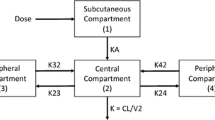Abstract
In an attempt to evaluate the propranolol (P) concentration-effect relationship, percentage reduction in exercise heart rate was modeled as a function of unbound and total P concentrations using the linear, E max ,and sigmoid E max models. Nine volunteers underwent repeated treadmill exercise tests over 48 hr during a control period, after receiving 160 mg of P orally and again after receiving 160 mg once daily for 7 days. Beta blockade was assessed as the percentage reduction in exercise heart rate compared to control. Total serum P concentrations were determined by HPLC and unbound fractions by equilibrium dialysis. Using nonlinear least-squares regression, the E max model was best in describing the concentration-effect relationship in each subject. Mean parameters for combined single dose and steady state were E max 33.6±4.5% and EC50 18.2±15.6ng/ml for total P and E max 33.5±4.3% and EC50 1.66±1.56 for unbound P. Model fits were not significantly better for unbound versus total P and EC50 values showed similar intersubject variability. The observed unbound EC50 values are consistent with reported receptor dissociation constants. Therefore the large intersubject variability in EC50 could not be accounted for by variability in P protein binding.
Similar content being viewed by others
References
C. K. Svensson, M. N. Woodruff, and D. Lalka. Influences of protein binding and use of unbound drug concentrations. In W. E. Evans, J. J. Schentag, and W. J. Jusko (eds.),Applied Pharmacokinetics, 2nd ed., Applied Therapeutics Inc., Spokane, WA, 1986, pp. 187–219.
M. Yasuhara, J. Fujiwara, S. Kitade, H. Katayama, K. Okumura, and R. Hori. Effect of altered plasma protein binding on pharmacokinetics and pharmacodynamics of propranolol in rats after surgery: Role of alpha-1-acid glycoprotein.J. Pharmacol. Exp. Ther. 235:513–520 (1985).
J. D. Huang and S. Øie. Effect of altered disopyramide binding on its pharmacologic response in rabbits.J. Pharmacol. Exp. Ther. 223:469–471 (1982).
D. G. McDevitt, M. Frisk-Holmberg, J. W. Hollifield, and D. G. Shand. Plasma binding and the affinity of propranolol for a beta receptor in man.Clin. Pharmacol. Ther. 20:152–157 (1976).
E. Perucca, R. Grimaldi, G. Gatti, M. Caravaggi, F. Crema, S. Lecchini, and G. M. Frigo. Pharmacokinetic and pharmacodynamic studies with a new controlled-release formulation of propranolol in normal volunteers: a comparison with other commercially available formulations.Brit. J. Clin. Pharmacol 18:37–43 (1984).
C. Chidsey, M. Pine, L. Favrot, S. Smith, G. Leonetti, P. Morselli, and A. Zanchetti. The use of drug concentration measurements in studies of the therapeutic response to propranolol.Postgrad. Med. J. 52(Suppl. 4):26–32 (1976).
D. J. Coltart and D. G. Shand. Plasma propranolol levels in the quantitative assessment of beta-adrenergic blockade in man.Brit. Med. J. 3:731–734 (1970).
J. McAinish, N. S. Baber, R. Smith, and J. Young. Pharmacokinetic and pharmacodynamic studies with long-acting propranolol.Brit. J. Clin. Pharmacol. 6:115–121 (1978).
M. Wood, D. G. Shand, and A. J. J. Wood. Altered drug binding due to use of indwelling heparinized cannulas (heparin lock) for sampling.Clin. Pharmacol. Ther. 25:103–107 (1979).
M. W. Lo, B. Silber, and S. Riegelman. An automated HPLC method for the assay of propranolol and its basic metabolites in plasma and urine.J. Chromatogr. Sci. 183:126–131 (1982).
J. Huang. Errors in estimating the unbound fraction of drugs due to the volume shift in equilibrium dialysis.J. Pharm. Sci. 72:1368–1369 (1983).
N. H. G. Holford and L. B. Sheiner. Kinetics of pharmacologic response.Pharmacol. Ther. 16:143–166 (1982).
C. M. Metzler and D. L. Weiner.PCNONLIN User's Guide, Statistical Consultants Inc., Lexington, MA, 1984.
H. Akaike. An information criterion.Math. Sci. 14(153):5–9 (1976).
E. M. Landaw and J. J. DiStephano III. Multiexponential, multicompartmental and noncompartmental modeling. II. Data analysis and statistical considerations.Am. J. Physiol. 246:R665–677 (1984).
R. J. Straka, R. L. Lalonde, J. A. Pieper, M. B. Bottorff, and D. M. Mirvis. Nonlinear pharmaeokinetics of unbound propranolol after oral administration.J. Pharm. Sci. 76:521–524 (1987).
D. G. McDevitt and D. G. Shand. Plasma concentration and time-course of beta-blockade due to propranolol.Clin. Pharmacol Ther. 18:708–713 (1975).
T. D. Bjornsson, J. R. Brown, and C. Tschanz. Importance of radiochemical purity of radiolabeled drugs used for determining plasma protein binding of drugs.J. Pharm. Sci. 70:1372–1373 (1981).
A. Goldstein, L. Aronow, and S. H. Kalman.Principles of Drug Action: The Basis of Pharmacology. Wiley, New York, 1974, pp. 82–89.
O. E. Bradde, K. Karad, H. R. Zerkowski, N. Rohm, and J. C. Reidemeister. Coexistence of beta-1 and beta-2 adrenoceptors in human right atrium.Circ. Res. 53:752–758 (1983).
H. Harms. Isoproterenol antagonism of cardioselective beta adrenergic receptor blocking: A comparative study of human and guinea-pig cardiac and bronchial beta adrenergic receptors.J. Pharmacol. Exp. Ther. 19:329–335 (1976).
J. F. Mullane, J. Kaufman, D. Duornik, and J. Coelho. Propranolol dosage, plasma concentration, and beta-blockade.Clin. Pharmacol. Ther. 32:692–700 (1982).
J. G. Wagner. Kinetics of pharmacologic response.J. Theoret. Biol. 20:173–201 (1968).
R. Platzer, R. L. Galeazzi, W. Neiderberger, and J. Rosenthaler. Simultaneous modeling of bopindolol kinetics and dynamics.Clin. Pharmacol. Ther. 36:5–13 (1984).
Author information
Authors and Affiliations
Rights and permissions
About this article
Cite this article
Lalonde, R.L., Straka, R.J., Pieper, J.A. et al. Propranolol pharmacodynamic modeling using unbound and total concentrations in healthy volunteers. Journal of Pharmacokinetics and Biopharmaceutics 15, 569–582 (1987). https://doi.org/10.1007/BF01068413
Received:
Revised:
Published:
Issue Date:
DOI: https://doi.org/10.1007/BF01068413




